
Entering a New Space Business
— It’s been said that you are the first private enterprise to attempt to clean up space debris.
Our mission is to secure long-term spaceflight safely by solving space debris issues. To achieve this, ASTROSCALE will extend its business model to a debris removing technology after gaining an understanding of the present space environment. As our first step, we investigate how much space debris exist in outer space. The size of space debris varies, and it is important to ascertain its density etc.
Ten cm or larger debris in the orbit are tracked from the ground-based infrastructures like telescopes and it is said to be over 17,000 objects in space. As technology advances, we will be able to track space debris from the ground if the size is larger than a few centimeters. However, it’s estimated that there are over 100 million pieces of debris smaller than 1cm. Since over 10 cm sized space debris can be detected from the ground, spacecrafts can change their orbit to avoid collisions with them, whereas they cannot avoid smaller pieces of debris and can often lead to damage. There is a need to remove larger sized space debris, while we can still see them, to prevent collisions or explosions that may create more debris. ASTROSCALE also sees the need for data of sub-millimeter sized debris and raising awareness on the space environment to improve spacecraft’s design for safe spaceflight in the future.
— What kind of satellite is Astroscale developing?
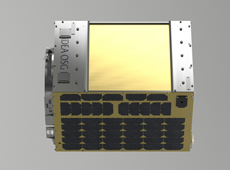 Final drawing of IDEA OSG 1 ©ASTROSCALE
Final drawing of IDEA OSG 1 ©ASTROSCALE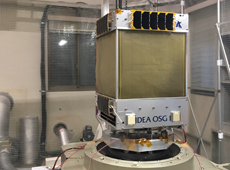 Flight model of IDEA OSG 1 ©ASTROSCALE
Flight model of IDEA OSG 1 ©ASTROSCALE
We are currently developing two different satellites. The first satellite is called “IDEA OSG 1.” It will study the size and position of space debris to create debris distribution maps and to help understanding the space environment. The size of this satellite is 60 cm height, 40 cm width, and 40 cm length. IDEA OSG 1 has impact sensors called space debris monitor (SDM) developed by Japan Aerospace Exploration Agency (JAXA). The SDM has conductive lines, and it can measure the size of the space debris from the number of line that are cut out by sub-millimeter size debris. Along with location data, this is transmitted back to Earth in almost real time for analyzing, therefore creating a map of space debris that will let us see the approximate size and altitude. This information will be beneficial for future satellites to determine its impact shielding design.
The second satellite is called ELSA and it will remove spacecraft in the end of its life. The size of ELSA is 1m height, 60 cm width, 60 cm length. A great number of satellites are scheduled to be launched in the next five to ten years. Those satellites need to re-enter the atmosphere and burn up after they complete their mission to preserve the space environment. This is called post-mission disposal (PMD). ELSA is equipped with a unique capturing mechanism that will be able to grab a dead satellite and then push it into the atmosphere, where both will be burned up. We hope to use it to remove debris weighing up to 500 kilograms.
— How is work on the satellites proceeding?
We planned to begin debris removal operations within seven years of incorporation. Three years and a half have passed since we established in 2013. We are concurrently under development of the debris observation satellite and the debris capture satellite. Development of IDEA OSG 1 has already been completed and it will be launched from a Russian spaceport this year. The debris removal satellite ELSA was originally being developed under the name of ADRAS 1, but the team revised a part of the design to respond to potential customers’ needs. We plan to conduct a demonstration of ELSA in space from late 2018 through 2019. ASTROSCALE aims to start debris removal operations in 2020, so we are in discussion with international institutions to make this a reality.
Cleaning Up Space Debris
— Astroscale is the only private enterprise in the world to attempt to clean up space debris. What was your motivation for setting up this business?
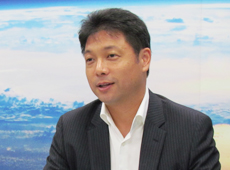
I had a midlife crisis when I was 40. I thought I was doing OK because that I had a successful career in IT industry and others. One day, I realized that I was not contributing anything to society, and I spent my time wondering whether this was a way of my life. In the midst of all this, I recalled my childhood passion for space. I remembered participating in a NASA astronaut experience program when I was 15 years old. I had the opportunity to meet the astronaut Dr. Mamoru Mohri, and he gave us a handwritten message, “Space is waiting for your challenge.” I was able to revisit my love for space, and I wanted to embrace this feeling, this was when I decided to do something related to space. Serendipity with Dr. Mohri created who I am now.
In February, 2013, I attended a space conference and learned space debris was becoming a serious problem. I went to a conference in Germany on space debris two months later since I wanted to gain a better understanding of solutions for the problem. Surprisingly, there were no concrete solutions. Research and proposals for solving the debris problem were presented, but there was no actions discussed. That is how I decided to solve the debris problem, and I set up the company the following month. Although others said there was no market for space debris removal, I saw it differently. I was sure this was a great opportunity since there will be no competitors.
Protecting our Customers’ Satellites from Space Debris
— What challenges have you encountered in founding a space business?
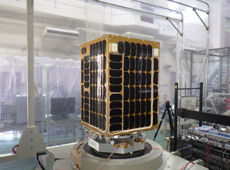 IDEA OSG 1 in testing ©ASTROSCALE
IDEA OSG 1 in testing ©ASTROSCALE
I would say there are five risks rather than challenges: technical, financial, legal, communication… and the risk of not having business model. Debris removal technology is still up in the air, so there is no solid business model yet. We were fortunate enough to be funded four billion yen from public and private funding such as the Innovation Network Corporation of Japan, and others, however, there is always a risk of running short of funding. Regarding regulation and law, we run into a lot of legal obstacles because there are no international rules for debris removal. On top of all of these, public awareness towards debris problem is very limited. It is very difficult for general public to be aware and understand it. Being in a position of CEO, I have to deal with all of these risks.
— Is a space-cleaning business feasible?
ASTROSCALE was able to get investors since they see space debris removal as a promising business. I cannot explain in details for now, but it will not be long before we can commercialize this business model – we will most likely start mass-production of debris-removal satellites by 2020. If we say, for example, “we want to clean up junk, so please give us some money”, nobody is willing to do so. Instead, it makes economic sense if we phrase it as “we are going to improve the continuity of your service, so you could compensate us for the service.
All of the different entities throughout the world that have or are planning satellite constellations are potential customers. Satellite constellations are arranged in orbits a certain distance apart, but if a satellite is unable to de-orbit after the end of its mission and becomes debris, a new satellite cannot put back in the same position. In the case of a communications satellite, for example, communication services can no longer be provided in the vicinity of the debris. Avoiding such a situation would require additional hardware and propellant to increase the probability of a successful Post-mission Disposal(PMD), and this would increase in costs. Considering all, we can propose “we will clean up if you have an unsuccessful PMD”, then we meet the needs of the market, therefore our business model is feasible.
A Safe Environment for Spacecraft
— What hopes do you hold for JAXA?

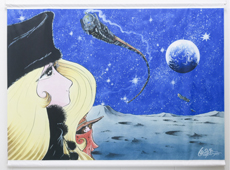 Art presented by Leiji Matsumoto ©Leiji Matsumoto ©ASTROSCALE
Art presented by Leiji Matsumoto ©Leiji Matsumoto ©ASTROSCALE
When I first learned about the debris issues, I thought about making a game about space debris using my expertise on IT industry. I even took a proposal to JAXA for further discussion about using their logo, and so on. That was my first discussion with a space agency. Several debris researchers were nice enough to participate in the meeting and we discussed the debris problem. After all, I ended up making satellites instead of a game. I am extremely grateful to JAXA for their sincere response. They inspired me to start this space business.
It would be great if JAXA could provide more opportunities to people from outside of the space industry to talk with. I am sure many more would be inspired and they will enter the space ventures. Japan has less than ten space ventures whereas over a thousand of companies exists in the United States, and several hundreds in Europe. I feel a bit struggled at the moment because we cannot form a supply chain without fifty companies at least. Investors are also reluctant to get involved in a business with no competitors. As I was inspired, I hope JAXA to be an inspiration and a great supporter for space ventures and entrepreneurs.
— Please share with us your thoughts about the future.
There is an artwork in our factory. It was given by a famous manga artist, Mr. Leiji Matsumoto. It illustrates my dream: a train travelling through space between Earth and the moon. One day, we will have a regular transportation service between Earth and the moon, where people are able to freely come and go. Our mission exists to secure long-term spaceflight safety in the future where people are not worried about space debris. There are many difficulties to achieve the dream, but I welcome the challenge.
Nobu Okada
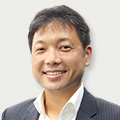
Founder and CEO, ASTROSCALE PTE., LTD.
Nobu Okada founded ASTROSCALE PTE. LTD. in Singapore in 2013 due to a strong desire to address the growing threat of space debris. R&D Center in Japan was also set up in February 2015. Prior to ASTROSCALE, Mr. Okada was a Japanese IT entrepreneur and strategy consultant, and had managed IT companies in several countries. Before joining the IT industry, he worked for McKinsey & Company and the Japanese Government in the Ministry of Finance. He earned his bachelor’s degree in Genetics from the University of Tokyo and an MBA from the Krannert School of Business, Purdue University.
[ April 26, 2017 ]
- Preventing Collisions Between Debris and Spacecraft
- Harnessing the Power of the Private Sector to Clean Up Space Junk
- Global Efforts to Deal with the Problem of Space Debris